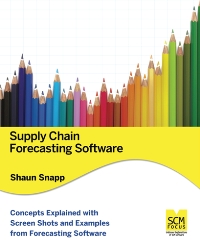 In 2011 I came across Shaun Snapp’s blog (scmfocus.com), and immediately took a liking. In particular, I was drawn to his independent and critical tone, and a willingness to challenge the “objectivity” of many commentators and advisors in the forecasting industry. He also takes a reasoned look at the common dogmas of our profession, with an eye to encouraging what can work, while exposing the marketing fluff and shoddy thinking of the really bad ideas. He is not just another cheerleader hyping the latest forecasting buzzword or fad.
In 2011 I came across Shaun Snapp’s blog (scmfocus.com), and immediately took a liking. In particular, I was drawn to his independent and critical tone, and a willingness to challenge the “objectivity” of many commentators and advisors in the forecasting industry. He also takes a reasoned look at the common dogmas of our profession, with an eye to encouraging what can work, while exposing the marketing fluff and shoddy thinking of the really bad ideas. He is not just another cheerleader hyping the latest forecasting buzzword or fad.
Shaun’s new book “Supply Chain Forecasting Software” is easy to get through, with points illustrated by screen shots from real forecasting software. The book is not a product-by-product review of the offerings of software vendors (which is what I was originally expecting). Instead, he covers several fundamental topics of a supply chain forecasting process (like statistical forecasting, consensus, collaboration, error management, and lifecycle planning). He also provides numerous links to blog posts where he goes into further detail on these and related topics.
In a chapter on attributes-based forecasting, Shaun argues for the importance of flexible, user-defined hierarchies (as opposed to the static hierarchies that are defined and locked-in during implementation of many software packages.) An attribute is anything that is associated with a product, such as physical characteristic like color or size, or any other categorization (e.g. location, season, target audience). With flexible hierarchies, a user can organize data, model, and generate forecasts in a way that is most suitable for the particular situation.
There is also a chapter devoted to forecastable versus unforecastable products, which is an important consideration for anyone trying to manage a supply chain. Rather than expecting to achieve a high level of accuracy for all products, or wasting resources pursuing unachievable levels of accuracy, Shaun shares ideas for identifying and dealing with the unforecastable.
“Supply Chain Forecasting Software” is a fast and worthwhile read for anyone involved with business forecasting. It would be particularly valuable for organizations engaged in the selection of forecasting software, or that have implemented forecasting systems and processes, yet are failing to see the expected/promised results. This book can help any forecaster understand why their efforts may be failing, and what they can do about it.

1 Comment
Pingback: Len Tashman previews Summer 2013 issue of Foresight